June: Everywhere, light and life
Frontenac State Park Association newsletter
Vol. 2, No. 6, June 2024
Questions, comments, complaints, compliments, contributions (especially contributions!)? Newsletter editor Pamela Miller can be reached at pamelamarianmiller@gmail.com.
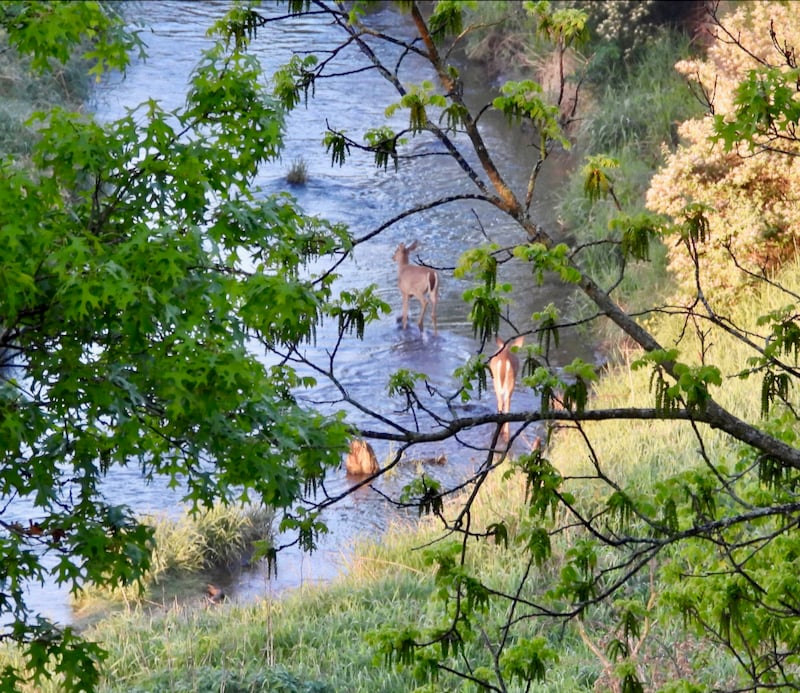
June: Everywhere, light and life
Rain, glorious rain! May brought reams of it to our area, easing worries about thirsty trees and prolonged drought. The woods and prairies of Frontenac State Park drank it in, and morel mushroom hunters were delighted (nope, nope—still not telling you all where they might have been in the park). And now comes June, that gorgeous month of long, languid days and everything greener than Ireland. (And yes, the rain also brought more mosquitoes—good for insect-eating birds, of course—so don’t forget your bug spray when you visit the park.)
Summer is nigh, and so lots of interesting events are planned in our beloved park. Here’s what to expect in June and July:
June 2024
Saturday, June 8: Free park entry day; FSPA will have a welcome table from 11 a.m. to 2 p.m. at the main picnic shelter.
Saturday, June 8, 9-11 a.m.: Guided bird walk with Master Naturalists/FSPA members Janet Malotky and Steve Dietz, leaving from campground kiosk.
Saturday, June 8, 10-11 a.m.: Nature walk with interpretive naturalist and FSPA member Bruce Ause, leaving from campground kiosk.
Tuesday, June 11, 10-11 a.m.: Nature Explorers: Wildflowers, for preschoolers, with interpretive naturalist Sara Holger, main picnic shelter.
Saturday, June 15, 10-11 a.m.: Nature walk with interpretive naturalist and FSPA member Bruce Ause, leaving from campground kiosk.
Saturday, June 15, 10 a.m.-noon: Park manager Jake Gaster leads a walk-and-talk on post-fire ecology, leaving from campground kiosk.
Saturday, June 22, 9-11 a.m.: Guided bird walk with FSPA members and Master Naturalists/FSPA members Janet Malotky and Steve Dietz along Prairie Loop Trail, leaving from park headquarters.
Saturday, June 22, 10-11 a.m.: Nature walk with interpretive naturalist and FSPA member Bruce Ause, leaving from campground kiosk.
Saturday, June 29, 10-11 a.m.: Nature walk with interpretive naturalist and FSPA member Bruce Ause, leaving from campground kiosk.
July 2024
Saturday, July 6, 10-11 a.m.: Nature walk with interpretive naturalist and FSPA member Bruce Ause, leaving from campground kiosk.
Saturday, July 6, 7 p.m.: Starry, Starry Night program with the Rochester Astronomy Club, beginning with a 45-minute presentation at the picnic shelter before star viewing from the main parking lot.
Tuesday, July 9, 10-11 a.m.: Nature Explorers: Insects, for preschoolers, with interpretive naturalist Sara Holger, main picnic shelter.
Saturday, July 13, 9-11 a.m.: Guided bird walk with FSPA members/Master Naturalists Janet Malotky and Steve Dietz, leaving from campground kiosk.
Saturday, July 13, 10-11 a.m.: Nature walk with interpretive naturalist and FSPA member Bruce Ause, leaving from campground kiosk.
Saturday, July 20, 10-11 a.m.: Nature walk with interpretive naturalist and FSPA member Bruce Ause, leaving from campground kiosk.
Saturday, July 27, 9-11 a.m.: Guided bird walk with FSPA members/Master Naturalists Janet Malotky and Steve Dietz, Sand Point Trail. Meet at the Sand Point Trail parking lot.
Saturday, July 27, 10-11 a.m.: Nature walk with interpretive naturalist and FSPA member Bruce Ause, from campground kiosk.
Saturday, July 27, 1-2 p.m.: “What Are Mussels?” Learn why freshwater mussels are key to healthy streams and lakes in Minnesota, and about what the state Department of Natural Resources is doing to restore freshwater mussel populations. A program offered by the park and the Lake City Mussel Lab. Meet at the picnic shelter.
Report from our ranger
Jake Gaster, our trusty, hard-working, tall, windblown and sometimes slightly sooty (from prescribed burns) park manager, offered these updates:
Attendance has been higher than average with the mild weather this late winter and spring. Some rainy weekends lowered the totals a bit, but camping has been hopping. [See the graphics below for details.]
We’ve had a surprisingly good May for burning. We were able to get four burns done, totaling just over 100 acres, including the bluffside forest just beneath the main overlook.
The reclamation and resurfacing of our park road (County Road 28 Boulevard) went splendidly. All the paving is done, and the only work left is adding the white stripes on the outside of the lanes and replacing the existing guard cable on the way up the hill into the park with new safety rails, both of which should happen soon [perhaps, dear readers, by the time you read this newsletter].
Our new park entrance sign, a replica of the unique design in the old sign that was widely loved (but the old one deteriorated over the years and finally fell down) is likely to be installed by the end of June. A big thanks to the Frontenac State Park Association [newsletter editor’s proud insert—THAT’S US!] for the funds they raised to support the installation.


Making our park even better
Your Frontenac State Park Association, a bunch of busybodies if ever there was one (in the best possible way!) was lively in May, leading nature walks focused on habitat diversity, birds or fungi; setting up more bird feeders at the main park picnic shelter; reaching out to diverse communities; purging invasives and improving habitats.
Building a new trail: When Great River Greening, an environmental restoration nonprofit, hosted a May work day at the park, several FSPA members showed up to help clear invasives in the beautiful new area of the park on the southwest side of Hill Avenue, where new trails are being established. (More on that in upcoming newsletters.) A big thank-you to everyone who helped!
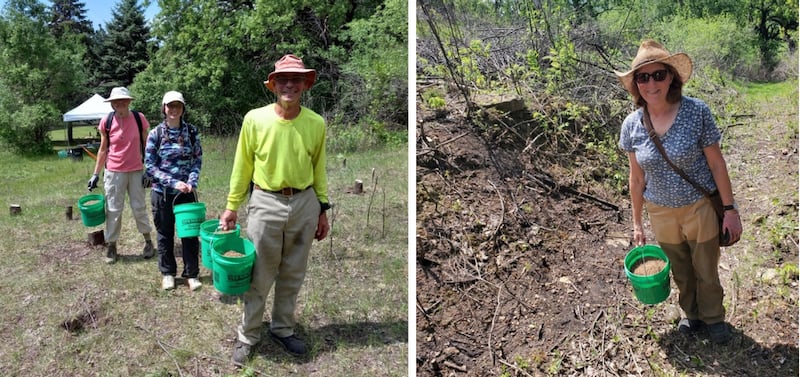
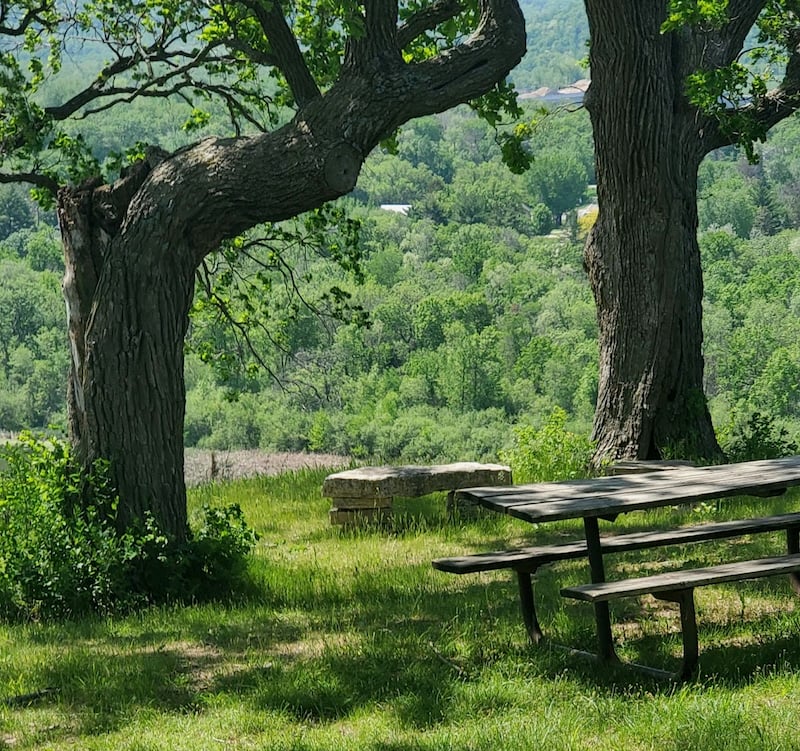
Habitat for birds

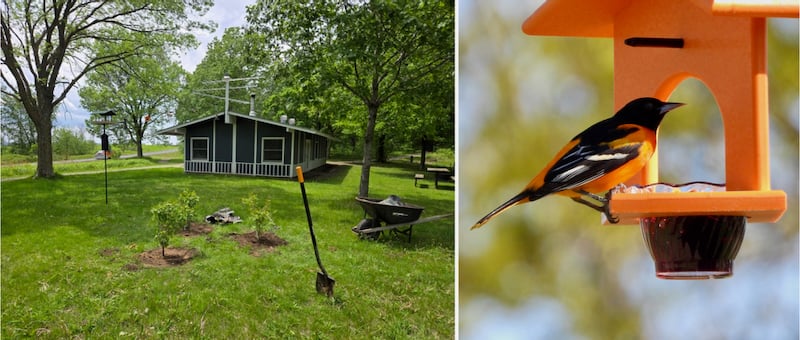
A wonderful way to introduce children to nature
Attendance was slim at our first Nature Explorers session for children ages 3-6 in May; we had more volunteers than kids. Too bad, because interpretive naturalist Sara Holger does a terrific job of engaging with and teaching little ones. Since then, we’re doing better at getting the word out about these monthly events. Bring your wee ones to our next sessions!:
Tuesday, June 11, 10-11 a.m.: Nature Explorers: Wildflowers; main picnic shelter.
Tuesday, July 9, 10-11 a.m.: Nature Explorers: Insects; main picnic shelter.
Here’s our handy flier
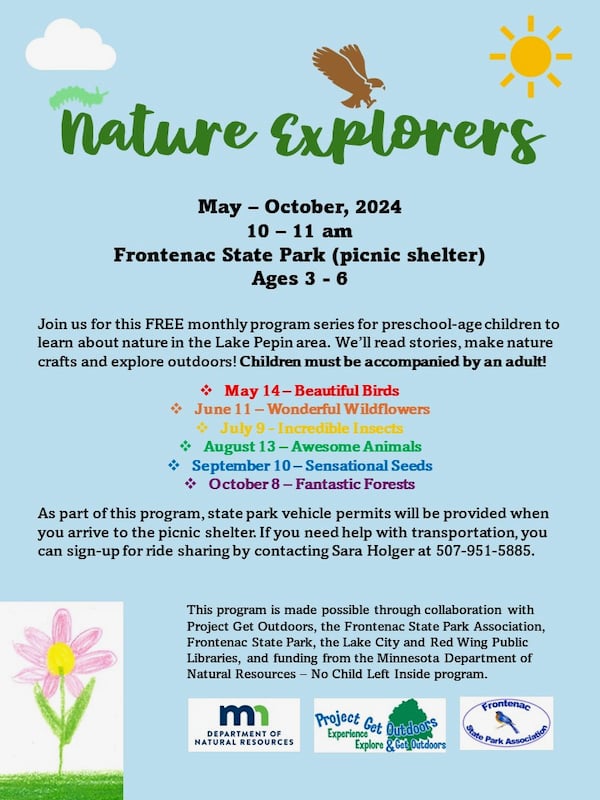
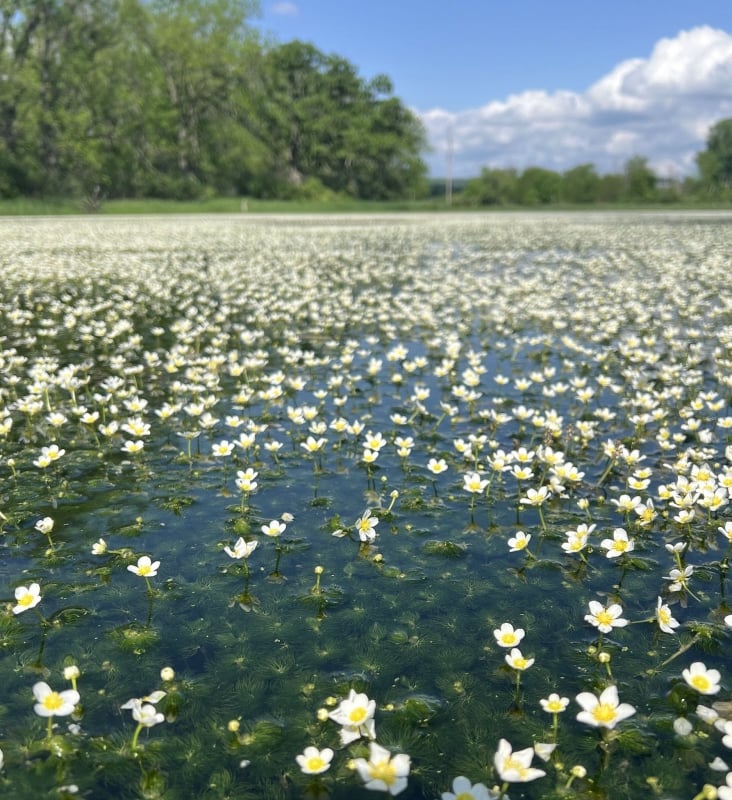
Bird note: Frontenac idol
By Janet Malotky, Master Naturalist volunteer and FSPA member
Any list of competitors for best singer in Frontenac State Park has to include perennial fan favorite the Eastern Meadowlark. Perched atop a tall spike of grass, shrub, fencepost or utility wire, the meadowlark throws back its head, opens wide its long, sharp bill, and belts sweet, flutey notes across the prairie. It comes dressed for the occasion too, with a back spangled brown and black, and undersides a glowing gold. It wears a bit of the gold as eyeshadow too, and across its breast is blazed a deep, black V.

Male meadowlarks sing during breeding season, and their song is a great harbinger of spring. Since they breed here in our park, you can readily hear and see them in their prairie habitat, especially in the morning.
One can often be seen on the wires along the prairie stretch of County Road 2 Boulevard, along with the Eastern Bluebirds and Tree Swallows. The male meadowlark’s singing establishes his territory, which he shares with two female meadowlarks.
The same birds return year after year to “their” territory, so perhaps, with careful observation, we could come to recognize each other over the years. Yeah, probably not, but it’s cool to think that the bird you hear this year could be the same one you’ve been hearing every spring for the last few years.
Meadowlarks nest on the ground in a cup nest built by the female. She lines a slight depression in the ground, such as a foot or hoof print, with grass, then lays two to seven eggs. The nest is well camouflaged by overgrowth.
If disturbed, the female may abandon her nest, so as tempting as it might be to try to see where a bird is nesting, that’s not a good idea. And if you come across a nest while bushwhacking, please do not touch it, and move away quickly. Once the chicks have fledged, the female may lay a second clutch of eggs and see them through to fledging as well.
Other than singing on visible perches, Eastern Meadowlarks spend most of their time on the ground. In addition to nesting there, they forage for the insects, grubs and worms that are their primary food source. To find these critters, they plunge their spear-like bills into the ground, then open their jaws to disturb the soil and reveal their prey.
In the winter, they eat weed seeds and wild fruits, but not around the park. Our birds leave for the southern United States sometime in November and don’t return until the snow has melted.
Frontenac State Park is also in the breeding range of Western Meadowlarks, birds nearly indistinguishable from Eastern Meadowlarks by looks. They sing a different song, though, and we have heard this song in the park. Possibly since the eastern birds have already established their territories on our prairie, the western birds don’t seem to stick around long. So most of the meadowlarks you’ll hear in the park will be eastern birds.
Along with many other prairie birds, meadowlarks are in sharp decline. Although there are still too many meadowlarks to meet the requirements for designation as a Species of Concern, the Eastern meadowlark population has been reduced by 75% over the past 50 years or so, mostly due to habitat loss. They need the prairies and wild, grassy fields that are not favored over our manicured lawns and vast monocultural farm fields. Many folks my age who grew up in rural places rarely hear these birds now, especially compared to when they were kids.
It would be so awesome to have them singing from every field again.
The name meadowlark suggests beautiful singing, but they aren’t actually members of the lark family. They’re in the blackbird family, along with the orioles, cowbirds, grackles and starlings. Of their cousins though, the meadowlarks surely have the most beautiful song. All we can say is, “Encore!”

Further afield: Mayflies in science, art and on your windshield
By Steve Dietz, Master Naturalist volunteer and FSPA president
Last July we told you about the ecological importance of mayflies as both food source and bioindicator. Since they are such a phenomenon— thankfully so—throughout the summer, we thought we’d flesh out their story with more details.
Such as this one from the famed German artist Albrecht Durer’s 1495 print “The Holy Family with the Mayfly,” where he included a mayfly in the lower right-hand corner to indicate, presumably, the ephemeral nature of life and, some scholars suggest, a “cosmic resonance between sacred and profane, celestial and terrestrial, macrocosm and microcosm."
Think about that for a second or two.

In art and literature, mayflies commonly represent life’s fleeting quality. Consider this description in the Epic of Gilgamesh, circa 2000 BCE:
Ever the river has risen and brought us the flood, the mayfly floating on the water. On the face of the sun its countenance gazes, then all of a sudden nothing is there.
It is important to remember, however, that in the mayfly’s pre-adult, nymph stages, it can live for more than a year underwater. Their adolescence ends in a brief but spectacular adulthood. Their relatively long composite lifespan, however, makes them an important bioindicator, subject as they are to water quality over time and not just in passing.
Mayflies are perhaps not as well known as American Woodcocks for their aerial displays of courtship, but in fact they don’t just mate in the air—they perform an elaborate dance that might be described as up-and-down movement, like a winged horse moving steadily if jerkily skyward. When the mayfly stops beating its wings, it gently falls, its abdomen almost vertical.
Check it out some summer evening. So sexy.
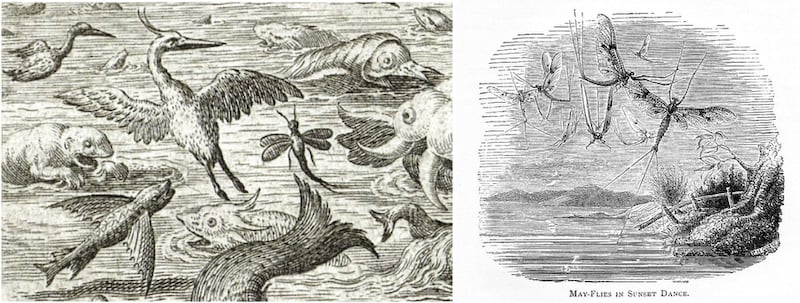
Mayflies often emerge in large numbers. That’s likely an evolutionary survival strategy, since any single mayfly is less likely to be eaten, statistically, when protected by the sheer numbers of the swarm, while at the same time, the hatch is an all-you-can-eat buffet for fish and birds. The hatch is often so large that it can be captured on radar by the NOAA weather station downriver in La Crosse, Wis., which has a web page for tracking mayflies.

Next time you are shoveling dead mayflies off your patio or cleaning your windshield, take a moment to appreciate that they have ancestral traits probably present in the first flying insects, a storied history in art and literature, indicate a healthy ecosystem, and can cut a pretty move on the dance sky.
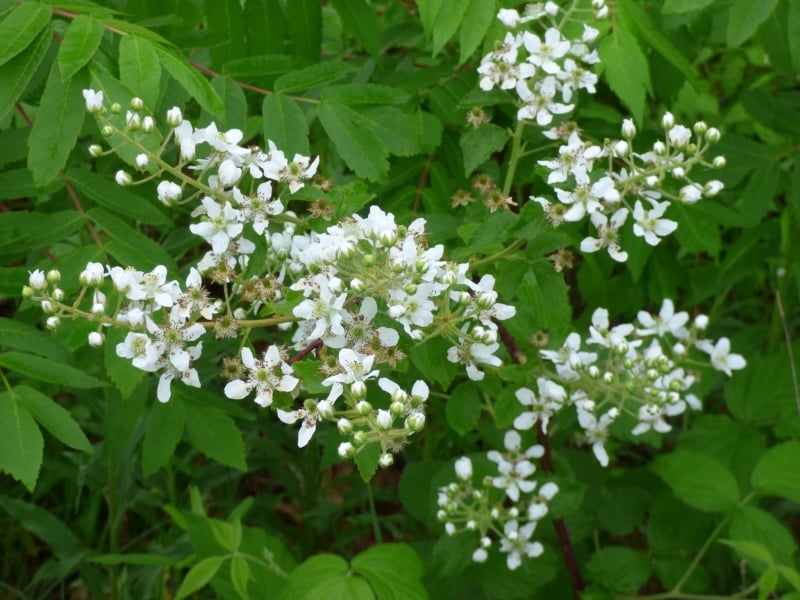

Poem of the month
“ALL IN JUNE”
By William H. Davies (Welsh, 1871-1940)
A week ago I had a fire
To warm my feet, my hands and face;
Cold winds, that never make a friend,
Crept in and out of every place.
Today the fields are rich in grass,
And buttercups in thousands grow;
I'll show the world where I have been—
With gold-dust seen on either shoe.
Till to my garden back I come,
Where bumble-bees for hours and hours
Sit on their soft, fat, velvet bums,
To wriggle out of hollow flowers.
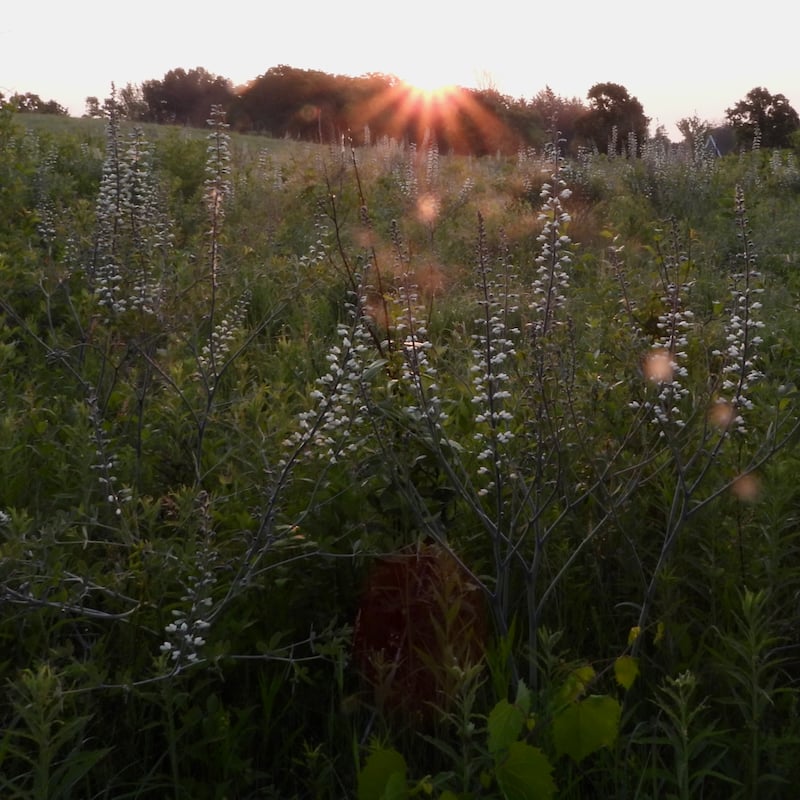
A sad note: The circle is broken; the circle is strong
This issue of our newsletter is dedicated to the memory of Dan Staker, an FSPA member who died unexpectedly of an aneurysm on May 23 at his home in Old Frontenac. Dan and his wife, Lynne, have been staunch and thoughtful advocates for Frontenac State Park and the Old Frontenac Historic District. We will miss him greatly. Peace to you, Dan, and to all of those who grieve for you.
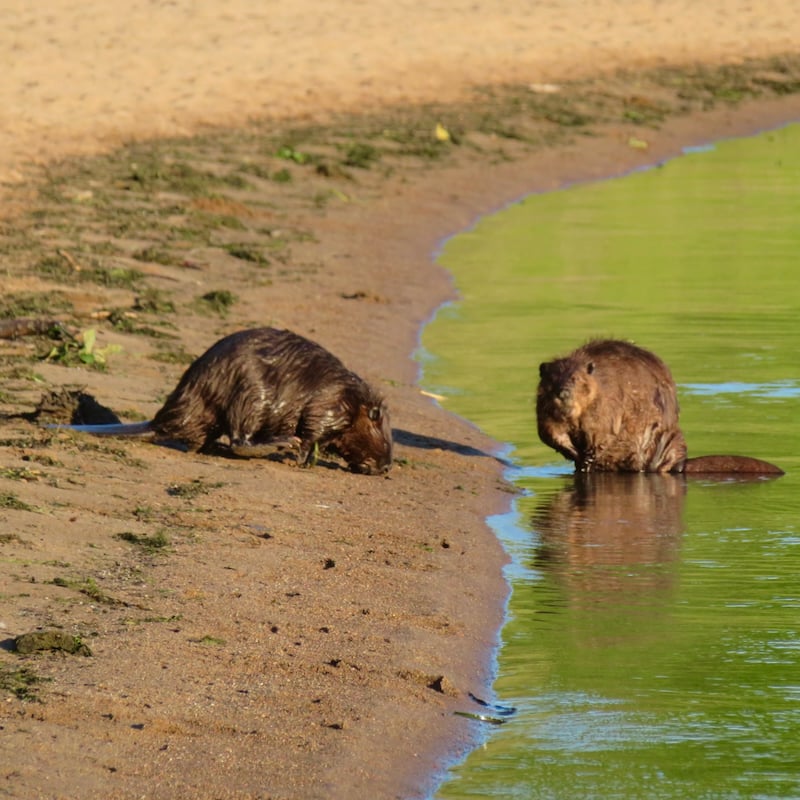
Interested in joining the FSPA?
We’d love to have your support (dues are $25 per year for an individual, $35 for dual/family membership). Here is a link.
A reminder that joining us occasionally to help the park out with volunteer efforts is awesome too, even if you’re not a member. The FSPA’s goal is simply to share our love of Frontenac State Park with as many people as possible.
To sign up to regularly receive this monthly newsletter, click on “Subscribe” below. Feel free to send questions or comments to your newsletter editor at pamelamarianmiller@gmail.com. Questions about the FSPA? You can reach FSPA chair Steve Dietz at stevedietz@duck.com.
Canada Geese and their maturing goslings in the morning mist. / Photo by Steve Dietz
Handy links for more information and education
Frontenac State Park website
Frontenac State Park Association website
If you take pictures in the park, tag us on Instagram
Frontenac State Park bird checklist
Frontenac State Park on iNaturalist
Parks & Trails Council
Website for our township, Florence Township
Minnesota Master Naturalist program
Red Wing Environmental Learning Center
Lake City Environmental Learning Program on FB
Visit Lake City
Frontenac State Park staff
Jake Gaster, park manager; Amy Jay, assistant park manager; Amy Poss, lead field worker
Parting shots
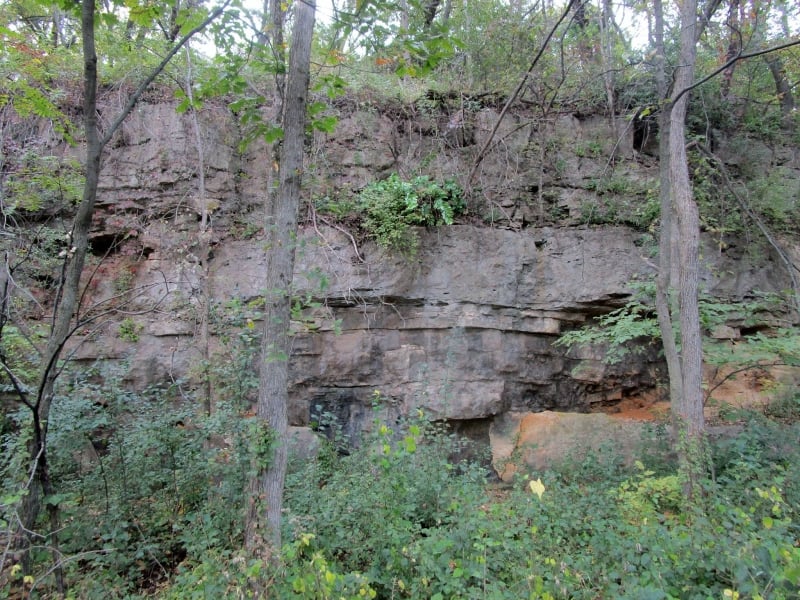

Thank you, readers and park visitors!
This is Volume 2, No. 6 of the Frontenac State Park Association newsletter, which was launched in April 2023.
Here’s where to browse the full archives of this newsletter.